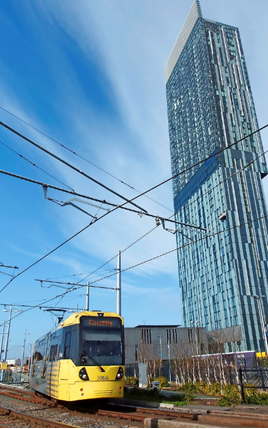“One of the more visible things to happen over time is that you’ll see more people on the network, and that increased presence will improve things like security, antisocial behaviour and the perception of personal safety on Metrolink. These things will make it a nicer place to travel.
“We’re hoping that we can grow patronage on the back of that and also from better operational reliability, and there are incentives in the contract based around this. We’ve got an interesting model and balance of risks here, because TfGM take the revenue risks, and it’s a managed contract with KeolisAmey for a fixed fee. We also take the whole life cost of renewals, and we can’t do that without an operator who’s providing that data and doing the condition monitoring. That’s an important element of this contract and that has to be a partnership. When the operator is incentivised to improve reliability, then the authority (TfGM) can only benefit from that growth in patronage.”
Looking further ahead, Vaughan could be responsible for implementing elements of TfGM’s 2040 Strategy (RAIL 823). Published in February, it sets out an ambitious vision for the City Region’s transport infrastructure and identifies its investment priorities for supporting the significant levels of economic and population growth expected over the next two decades.
Much of the strategy focuses on driving increased integration between different modes of public transport, to reduce the cost and time penalties of changing between services and to better co-ordinate travel by bus, tram and train.
With funding available from the £314 million Local Growth Fund awarded to Greater Manchester by central government in 2014 as part of the City Region’s devolution deal, many of the suggested improvements touch on Metrolink, and could come to define Vaughan’s leadership of the organisation over the coming years should they be given the green light.
They include resurrecting an idea first mooted in the 1970s to tunnel beneath the city centre to add rail-based capacity, and to introduce tram-trains on to some of the city’s suburban but financially-underperforming heavy rail routes. By sharing existing infrastructure with Network Rail, the latter would seem the more immediately achievable ambition, both for its significantly lower cost than tunnelling, and the shorter time horizons involved in converting conventional rail track to accept metro-style services.
Vaughan and his team will therefore be closely monitoring progress made on the UK’s first planned tram-train trial in Sheffield, which has been delayed because the infrastructure is not yet ready to introduce the seven tram-trains currently undergoing acceptance trials. In the longer term, however, he is a supporter of building tunnels - despite the obvious expense and engineering difficulties this might entail.
“Tram-trains are certainly one of the more achievable things in the strategy, but we don’t have any timelines on it,” adds Vaughan. “We’re keeping half an eye on what’s going on in Sheffield and have been waiting for some time to see the outcome of that trial, but you’d be mad to look at anything beyond the mid-2020s (to see tram-trains in Manchester). It depends on funding and how quick and receptive people like Network Rail are, and how it fits into their plans. There’s quite a lot of things that need to come together to make it happen, but I think the tram-train is in their interests too.
“Longer term, I don’t think Manchester could meet the aspirations it wants to by relying solely on the existing Metrolink lines across the city centre. I think we need to start seriously considering tunnels, which is obviously a very expensive type of infrastructure and would take a huge commitment, but why not?”
Vaughan is pragmatic, and accepts TfGM might well look to invest away from Metrolink in the short term and increase capacity across alternative modes of public transport.
High Speed 2 is due to arrive in Manchester in 2033, however, providing fresh opportunities for Metrolink, as will the planned £1 billion upgrade of Manchester Airport’s Terminals 2 and 3.
He concludes: “TfGM’s next 22 years is really wrapped up in our 2040 strategy. Metrolink has benefitted from lots of investment in the past few years, but we also have ambitions around the bus networks, the rail network and what we call the Greater Manchester Spatial Framework. With this you can see a timeline of investment going on in and around Manchester in housing and things like that, and we’re going to develop transport infrastructure around that spatial framework. In some cases that might mean new Metrolink routes, but it might mean building better roads or providing quality bus services.
“In some cases we are looking at Metrolink specifically, such as potentially building through Manchester Airport to a new Terminal 2, and possibly making some changes at Piccadilly station for when High Speed 2 arrives. There are also business cases for looking at new lines, such as perhaps one to Port Salford from the Trafford Park line. We have lots of ideas, and there will certainly be more to come from Metrolink.”
This feature was published in RAIL 826 on 6th May 2017















Comment as guest
Comments
No comments have been made yet.